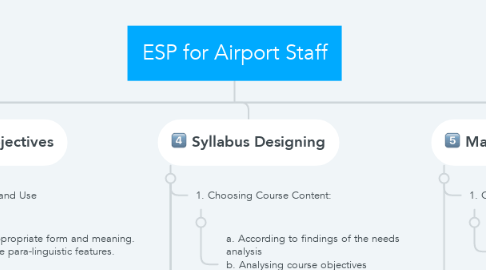
1. Examining Context
1.1. 1.Geographical Location - Beijing Capital International Airport.
1.2. 2. Organisational Concerns:
1.2.1. a. Needs of the government b. Travelling Community c. Users of the airport
1.3. 3. Expectations of the staff
1.4. 5. Course Duration
1.5. 6. Learner Profile
2. Needs Analysis
2.1. 1. Rationale:
2.1.1. a. Investigation of Necessities b. Linguistic Features c. Communicating Events
2.2. 2. Methods:
2.2.1. a. Questionnaire b. Interview c. Observation
2.3. 3. Data Collection:
2.3.1. a. Questionnaire b. Descriptive data from airport websites
2.4. 4. Findings
3. Identifying Objectives
3.1. 1. Language System and Use
3.1.1. a. Usage of appropriate form and meaning. b. Ability to use para-linguistic features.
3.2. 2. Target Performance
3.2.1. a. Identify service call sequences and expressions.
3.3. 3. Strategic Competence
3.3.1. a. Skimming and scanning. b. Identification of variations and etiquettes of email writing.
3.4. 4. Cross-cultural awareness
3.4.1. a. Identifying cultural differences.
3.5. 5. Critical Awareness
3.5.1. a. Critically examining the target practice b. Critically reflecting on situations from one's work experience
4. Syllabus Designing
4.1. 1. Choosing Course Content:
4.1.1. a. According to findings of the needs analysis b. Analysing course objectives c. Course designer's beliefs regarding language and learning
4.2. 2. Structuring Course Content- Adhering to Task Based Language Teaching (TBLT) syllabus framework
4.2.1. a. Target performance b. Strategic competence c. Cross-cultural awareness d. Language system and use
4.3. 3. Selecting Syllabus Framework:
4.3.1. a. Choosing the right methodology b. Selection and sequencing of tasks - basic to complex c. Language focus on specific activities d. Considering required aspects
4.4. 4. Structuring instructional blocks:
4.4.1. a. Providing syllabus to cover in a week duration b. Arranged in the form of ‘syllabus to be completed’ and ‘day’ categorization c. Formulating objectives in light of Basturkman's five general categories.
5. Material Designing
5.1. 1. Considering Required Aspects:
5.1.1. a. Language b. Skills c. Content
5.2. 2. Devising Pedagogical Tasks:
5.2.1. a. Tasks that enhance learners' real-world communication b. Designing texts for reading tasks
6. Learning Assessment
6.1. 1. Portfolio:
6.1.1. a. Strengths b. Weaknesses c. Needs
6.2. 2. Situational Roleplays:
6.2.1. a. Gauging learners' progress with portfolio
6.3. 3. Perspectives to Reflect
6.4. 4. Honing Negotiating Skills
7. Course Evaluation
7.1. 1. Parameters for Formative Evaluation:
7.1.1. a. Purpose b. Audience c. Participants d. Approach
7.2. 2. Basis for Evaluation:
7.2.1. a. Feedback b. Course progression
7.2.1.1. i. Analyzing video-tapes
7.2.2. 3. Approaches:
7.2.2.1. a. Qualitative -
7.2.2.1.1. i. Questionnaires ii. Video-recordings
7.2.2.1.2. b. Quantitative-
7.2.3. 4. Checklist
7.2.4. 5. Interpretation of collected data
